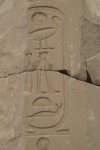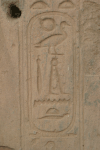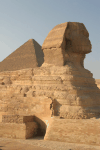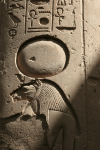A lot of the information on this page is from The Ancient Egypt Site (AES below), the site Ancient Egypt (AE below), and from Wikipedia. These sites have a lot of information and consistent time lines, although they differ. The hieroglyphic names are from both the AES and AE website. The times are all from the AE website.
From the First Intermediate Period of Egypt entry in Wikipedia:
The First Intermediate Period, described as a 'dark period' in ancient Egyptian history, spanned approximately one hundred and twenty-five years, from c. 2175–2049 BCE, after the end of the Old Kingdom. It comprises the 7th (although it is mostly considered spurious by Egyptologists), 8th, 9th, 10th, and part of the 11th Dynasties. The concept of a "First Intermediate Period" was coined in 1926 by Egyptologists Georg Steindorff and Henri Frankfort.
Very little monumental evidence survives from this period, especially from the beginning of the era. The First Intermediate Period was a dynamic time where rule of Egypt was roughly equally divided between two competing power bases. One of those bases was at Heracleopolis in Lower Egypt, a city just south of the Faiyum region. The other was at Thebes in Upper Egypt. It is believed that during this time temples were pillaged and violated, artwork was vandalized, and the statues of kings were broken or destroyed as a result of the postulated political chaos. These two kingdoms would eventually come into conflict, leading to the conquest of the north by the Theban kings and the reunification of Egypt under a single ruler, Mentuhotep II, during the second part of the 11th Dynasty. This event marked the beginning of the Middle Kingdom of Egypt.
The 7th and 8th Dynasties are often overlooked because very little is known about the rulers of these two periods. Manetho, a historian and priest from the Ptolemaic era, describes 70 kings who ruled for 70 days. This is almost certainly an exaggeration meant to describe the disorganization of the kingship during this time period. The 7th Dynasty may have been an oligarchy comprising powerful officials of the 6th Dynasty based in Memphis who attempted to retain control of the country. The 8th Dynasty rulers, claiming to be the descendants of the 6th Dynasty kings, also ruled from Memphis. Little is known about these two dynasties since very little textual or architectural evidence survives to describe the period. However, a few artifacts have been found, including scarabs that have been attributed to king Neferkare II of the 7th Dynasty, as well as a green jasper cylinder of Syrian influence which has been credited to the 8th Dynasty. Also, a small pyramid believed to have been constructed by King Ibi of the 8th Dynasty has been identified at Saqqara. Several kings, such as Iytjenu, are only attested once and their position remains unknown.
Sometime after the obscure reign of the 7th and 8th Dynasty kings a group of rulers arose in Heracleopolis in Lower Egypt. These kings comprise the 9th and 10th Dynasties, each with nineteen listed rulers. The Heracleopolitan kings are conjectured to have overwhelmed the weak Memphite rulers to create the 9th Dynasty, but there is virtually no archaeology elucidating the transition, which seems to have involved a drastic reduction in population in the Nile Valley.
The founder of the 9th Dynasty, Akhthoes or Akhtoy, is often described as an evil and violent ruler, most notably in Manetho's writing. Possibly the same as Wahkare Khety I, Akhthoes was described as a king who caused much harm to the inhabitants of Egypt, was seized with madness, and was eventually killed by a crocodile. This may have been a fanciful tale, but Wahkare is listed as a king in the Turin Canon. Kheti I was succeeded by Kheti II, also known as Meryibre. Little is certain of his reign, but a few artifacts bearing his name survive. It may have been his successor, Kheti III, who would bring some degree of order to the Delta, though the power and influence of these 9th Dynasty kings was seemingly insignificant compared to the Old Kingdom pharaohs.
A distinguished line of nomarchs arose in Siut (or Asyut), a powerful and wealthy province in the south of the Heracleopolitan kingdom. These warrior princes maintained a close relationship with the kings of the Heracleopolitan royal household, as evidenced by the inscriptions in their tombs. These inscriptions provide a glimpse at the political situation that was present during their reigns. They describe the Siut nomarchs digging canals, reducing taxation, reaping rich harvests, raising cattle herds, and maintaining an army and fleet. The Siut province acted as a buffer state between the northern and southern rulers, and the Siut princes would bear the brunt of the attacks from the Theban kings.
It has been suggested that an invasion of Upper Egypt occurred contemporaneously with the founding of the Heracleopolitan kingdom, which would establish the Theban line of kings, constituting the 11th and 12th Dynasties. This line of kings is believed to have been descendants of Intef, who was the nomarch of Thebes, often called the "keeper of the Door of the South". He is credited for organizing Upper Egypt into an independent ruling body in the south, although he himself did not appear to have tried to claim the title of king. However, his successors in the 11th and 12th Dynasties would later do so for him. One of them, Intef II, begins the assault on the north, particularly at Abydos.
By around 2060 BCE, Intef II had defeated the governor of Nekhen, allowing further expansion south, toward Elephantine. His successor, Intef III, completed the conquest of Abydos, moving into Middle Egypt against the Heracleopolitan kings. The first three kings of the 11th Dynasty (all named Intef) were, therefore, also the last three kings of the First Intermediate Period and would be succeeded by a line of kings who were all called Mentuhotep. Mentuhotep II, also known as Nebhepetra, would eventually defeat the Heracleopolitan kings around 2033 BCE and unify the country to continue the 11th Dynasty, bringing Egypt into the Middle Kingdom.
Following is the list of Egyptian Pharaohs as well as I could determine it:
All pictures are © Dr. Günther Eichhorn, unless otherwise noted.
| Name of Pharaoh | Dates | Birth Name | Coronation Name | Horus Name | Comment |
|---|---|---|---|---|---|
| (from The Ancient Egypt Site and Ancient Egypt) | |||||
First Intermediate Period (AES Wiki ) | 2175 - 2049 BCE | ||||
7th Dynasty (AES Wiki AE) | 2175 - 2165 BCE | ||||
| Neterikare (AES Wiki) | n/a | n/a | |||
| Menkare (Wiki) | n/a | ||||
| Neferkare II (Wiki) | n/a | n/a | |||
| Neferkare Neby (Wiki) | n/a | n/a | |||
| Djedkare Shemai (Wiki) | n/a | n/a | |||
| Neferkare Khendu (Wiki) | n/a | n/a | |||
| Merenhor (Wiki) | n/a | n/a | |||
| Neferkamin I (Wiki) | n/a | ||||
| Nikare (Wiki) | n/a | n/a | |||
| Neferkare Tereru (Wiki) | n/a | n/a | |||
| Neferkahor (Wiki) | n/a | n/a | |||
8th Dynasty (AES Wiki AE) | 2165 - 2140 BCE | ||||
| Neferkare VI Pepyseneb (Wiki) | n/a | ||||
| Neferkamin Anu (Wiki) | n/a | n/a | |||
| Qakare Ibi (Wiki) | n/a | ||||
| Neferkaure (Wiki) | n/a | ||||
| Neferkawhor Khwiwihepu (Wiki) | |||||
| Neferirkare II (Wiki) | n/a | n/a | |||
| Sekhemkare | n/a | n/a | |||
| Wadjkare | n/a | n/a | |||
| Iti | n/a | n/a | |||
| Imhotep | n/a | n/a | |||
| Hotep | n/a | n/a | |||
| Khwi | n/a | n/a | |||
| Isu | n/a | n/a | |||
| Iytenu | n/a | n/a | |||
9th Dynasty (AES Wiki AE) | 2140 - 2100 BCE | ||||
| Meryibre Kheti I (Wiki) | n/a | ||||
| Neferkare VII (Wiki) | n/a | n/a | |||
| Nebkaure Kheti II (Wiki) | n/a | n/a | |||
| Setut (Wiki) | n/a | n/a | n/a | ||
| Senen/// | n/a | n/a | |||
| Wahkare Kheti III (Wiki) | n/a | ||||
| Kheti IV | n/a | ||||
| Shed/// | n/a | n/a | |||
| Nebkaure | n/a | n/a | n/a | ||
10th Dynasty (AES Wiki AE) | 2100 - 2017 BCE | ||||
| Kheti V | n/a | ||||
| Meryhathor? (Wiki) | n/a | n/a | |||
| Neferkare VIII (Wiki) | n/a | n/a | n/a | ||
| Se///re Kheti V | n/a | n/a | |||
| Kheti VI | n/a | ||||
| Kheti VII | n/a | ||||
| Merikare (Wiki) | n/a | n/a | |||
11th Dynasty (AES Wiki AE) | 2134 - 1982 BCE | ||||
| Intef (Antef) the Elder (Wiki) | n/a | n/a | n/a | ||
| Mentuhotep I (Wiki) | 2130 - 2117 BCE | n/a | |||
| Intef (Antef) I (AES Wiki) | 2117 - 2105 BCE | ||||
| Intef (Antef) II (AES Wiki) | 2105 - 2057 BCE | ||||
| Intef (Antef) III (AES Wiki) | 2057 - 2049 BCE | n/a | |||
|
|
|
Middle Kingdom
|


This page contains 2 pictures
Here are the links to the other pages on Egypt:






Page last updated on Tue Nov 2 17:23:16 2021 (Mountain Standard Time)
Page last updated on Wed Apr 24 12:49:11 2024 (Mountain Standard Time)
Egypt - Pharaohs of the First Intermediate Period - 2175 - 2049 BCE on guenther-eichhorn.com